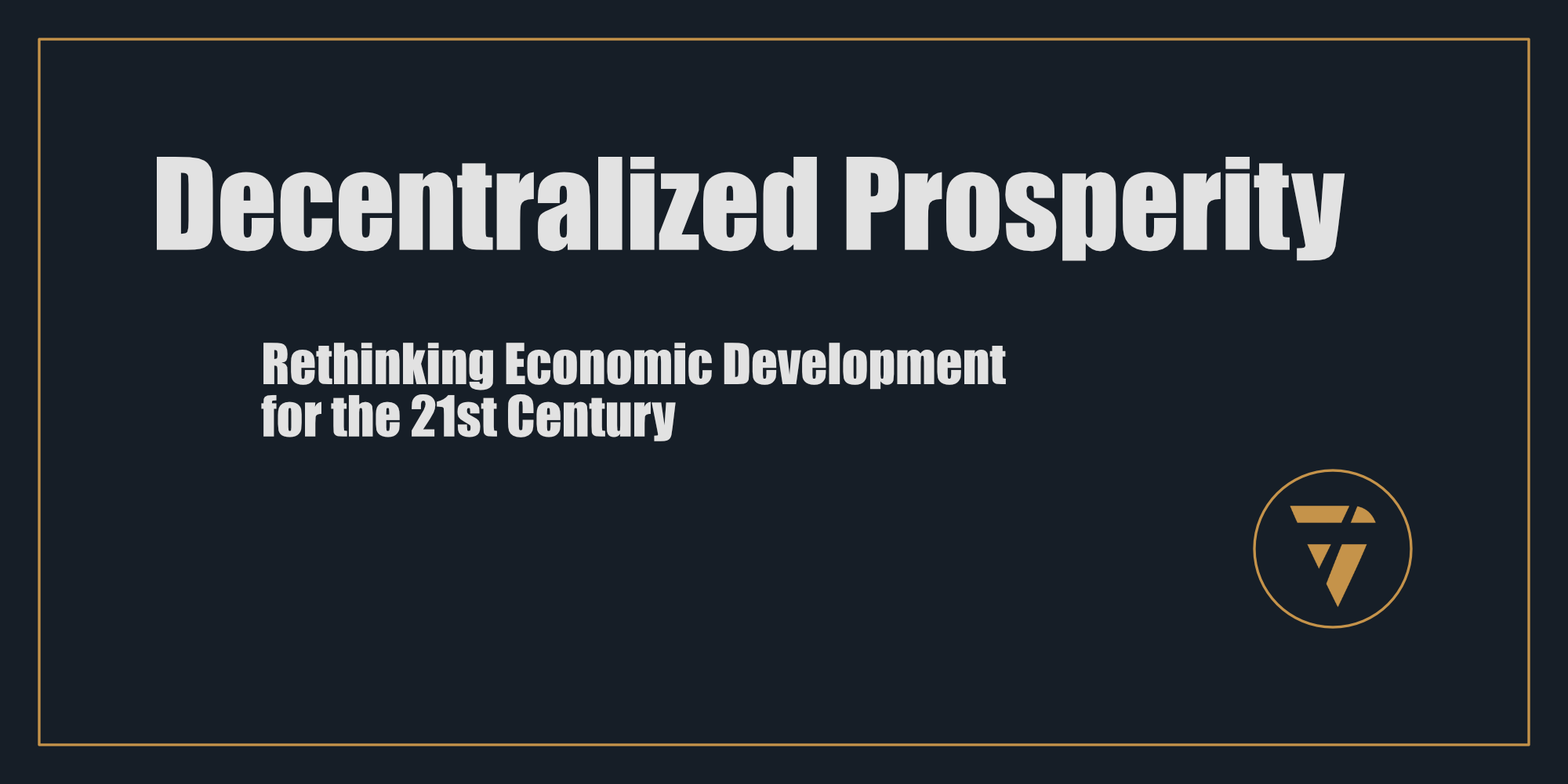Decentralized Prosperity

Rethinking Economic Development for the 21st Century
For decades, economic development followed a simple formula: centralize production, consolidate capital, and scale up at any cost. The assumption was that bigger was always better, that growth required cities to expand, corporations to merge, and global supply chains to stretch across continents.
This model created immense wealth, but at a cost:
- Small towns and rural economies hollowed out as industries relocated to urban centres.
- Local businesses disappeared under the weight of corporate consolidation.
- Global supply chains, optimized for efficiency, failed spectacularly in times of crisis.
Today, the cracks in this system are impossible to ignore. The world’s largest companies are also the most fragile. A single disruption—be it geopolitical, financial, or environmental—can ripple across the globe in days. Economic power is concentrated in the hands of fewer people, and entire industries rely on the decisions of a small elite with no direct connection to the communities affected by their choices.
This isn’t just inequality, it’s systemic fragility.
The alternative is decentralized prosperity, an economic model that prioritizes local resilience, distributes ownership, and fosters self-sustaining growth. This is not just an ideological shift, but a practical necessity for economic survival in the 21st century.
What Is Decentralized Prosperity?
Decentralized prosperity is an economic framework that shifts power away from large-scale, centralized systems and towards local, inter-connected networks of production, finance, and governance.
It is built on three core principles:
- Distributed Ownership: Wealth and decision-making should not be concentrated in a handful of corporations or institutions. Instead, they should be widely shared through co-operative business models, community investment funds, and localized financial systems.
- Local Economic Resilience: Communities should be able to sustain themselves without over-reliance on external corporations, imports, or distant financial markets. This means prioritizing local production, supply chain redundancy, and regional self-sufficiency.
- Adaptive Growth Over Scale: Instead of valuing businesses solely by their size, we must assess their adaptability, sustainability, and ability to support communities over the long term. Growth should be measured by how well an economy meets local need, not how many franchises expand globally.
Decentralized prosperity does not reject global trade or large-scale enterprise, it repositions them within a framework where local economies are not subservient to external forces. Instead of a monolithic economy, we must build an ecosystem of interconnected, autonomous economies.
Why the 20th-Century Growth Model Failed
The 20th century was defined by scale-driven industrialization. Large corporations and urban centres became the engines of growth. Governments encouraged policies that favoured corporate consolidation, believing that bigger businesses would create stable jobs and generate economic security.
Instead, centralization created inequality, economic volatility, and dependence on fragile supply chains. The flaws in this model became impossible to ignore:
- Geographic Inequality: As capital flowed into major urban centres, rural areas suffered economic stagnation and population decline.
- Corporate Dependency: Entire regions became reliant on a handful of major employers—when those businesses left, they collapsed overnight.
- Financial Volatility: Large-scale financial markets prioritized speculation over stability, leading to boom-and-bust cycles that wiped out generational wealth.
The result is an economy where:
- Rural communities are abandoned.
- Workers are disposable.
- Small businesses struggle against monopolistic giants.
Rather than addressing these failures, governments doubled down on centralization, bailing out corporations instead of investing in decentralized alternatives.
The modern economy does not need more corporate subsidies, tax breaks for multinational firms, or urban-centric development incentives. It needs to be rewired for decentralization.
How Decentralized Prosperity Works
A decentralized economic model redistributes power and resources, making communities more resilient, adaptable, and self-sufficient.
1. Localized Capital and Investment
One of the biggest obstacles to decentralization is that financial capital is centralized. Major investment firms, venture capital, and banks prioritize large-scale corporate growth over small, community-driven businesses.
Decentralized finance (DeFi), co-operative lending models, and community investment funds offer an alternative. These systems keep money circulating within local economies rather than extracting it.
- Public banking models can provide funding for small businesses without the pressures of corporate investors.
- Co-operative lending networks can allow businesses to access funding without relying on big banks.
- Decentralized cryptocurrencies and regional digital currencies can create local financial autonomy.
When capital remains within a community, businesses can grow without dependence on external investors.
2. Local Production Over Global Dependency
Supply chains optimized for efficiency are inherently fragile. When disruptions occur, businesses that rely on overseas production or centralized distribution networks collapse.
Instead of relying on import-heavy economies, decentralized prosperity prioritizes regional production.
- Small-scale manufacturing hubs can reduce dependency on global suppliers.
- Localized food systems ensure food security by reducing reliance on imports.
- Distributed energy networks (solar, wind, microgrids) keep power generation local and independent.
Every industry that moves from centralized production to local or regional models increases economic resilience.
3. Ownership and Governance That Stays Local
Decentralized prosperity distributes decision-making power rather than consolidating it in corporate boardrooms.
- Worker co-operatives replace shareholder-driven corporations, ensuring profits are reinvested into communities.
- Community land trusts prevent housing speculation and keep property ownership in local hands.
- Decentralized governance models allow residents to have real control over economic policies.
The result is an economic system where people make the decisions that shape their lives.
The Path Forward: Implementing Decentralized Prosperity
Transitioning from centralized fragility to decentralized strength requires a fundamental shift in mindset, policy, and economic structure. The following steps must be taken:
- Re-allocate Funding – Shift government incentives away from corporate subsidies and towards localized business support, co-operative development, and decentralized financial systems.
- Rebuild Regional Infrastructure – Invest in local production capacity, resilient supply chains, and community-driven financial institutions.
- Legislate Against Monopolization – Enforce antitrust policies that prevent monopolies from destroying local competition.
- Educate for Decentralization – Train entrepreneurs, policymakers, and investors in the principles of decentralized economic growth.
- Adopt Community-Led Policy Making – Transition economic governance from top-down corporate lobbying to bottom-up, locally driven decision-making.
Decentralization Is the Future
Centralized economic models are failing under their own weight. The global economy is increasingly volatile, and communities that depend on distant corporations for survival are at constant risk of collapse.
Decentralized prosperity is not a utopian ideal—it is a pragmatic solution to economic fragility. It redistributes wealth, increases stability, and ensures that prosperity is not dictated by a handful of corporations, but created by communities themselves. This is pure profit by performance.
The future of economic development does not belong to mega-corporations and speculative financial markets. It belongs to localized capital, decentralized ownership, and resilient, self-sustaining economies.
The only question is whether we will build that future now, or wait for centralized systems to fail completely before we act.
This is what I’m working on. Tell me what you think, I enjoy the conversation! Subscribe and follow the work in real time.
Thanks!
B

The economy wasn’t meant to be controlled by a handful of corporations. Real prosperity isn’t centralized, it’s built in communities, owned by people, and sustained through local resilience. The future isn’t bigger; it’s decentralized.
PS -

Decentralize your local economy for resilient, sustainable growth. Connect now and build your plan.






